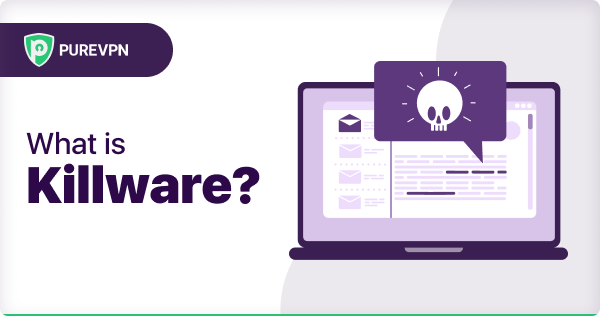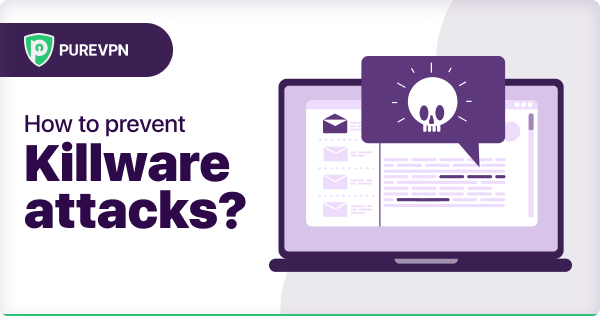The cybersecurity threat landscape is constantly changing and evolving. A new type of threat, killware, poses a significant threat to organizations, individuals, and industries. It works by encrypting files and deleting data, necessitating the need to be careful and have security systems in place to defend against such threats.

What is Killware?
Killware is a type of malware specifically designed to kill or disable any running software on your computer. Cybercriminals can also use killware to delete your private files and can take control of your computers and organization’s systems. Mostly, cybercriminals use it to disable the software or take control of any system’s specific security features.
Is Killware similar to ransomware?
As you know, Killware is a specific type of malware designed to cripple systems and security features; most people confuse it with ransomware attacks. Let’s understand the differences and similarities between ransomware and Killware.
Like ransomware, Killware uses malicious code to gain unauthorized access to any system and encrypt private data, sometimes rendering the affected system vulnerable until the victim pays a ransom to unlock it. But ransomware usually targets small businesses and individuals, while Killware targets big conglomerates and is a calculated cyberattack aimed at crippling sensitive systems and getting private information.
Although cybercriminals use various methods to deploy Killware, based on the victim and security systems, these attacks involve crippling vulnerable web servers that are commonly found within corporate networks. Once a cybercriminal penetrates your systems, they use it to deploy malware to other connected systems on the corporate network, via different methods, including but not limited to phishing and social engineering.
In conclusion, there are a few similarities between Killware and ransomware, but Killware is still a distinct type of malware with unique features and characteristics. And by understanding the main differences between these two emerging threats, you can protect yourself and your private systems from devastation.
Most common Killware targets
Killware targets a wide range of systems, conglomerates, and individuals based on the information they hold.
Individuals
Cybercriminals use Killware to extort money from individual targets by encrypting their data and threatening to delete or manipulate it. According to one reported story, a UK citizen fell victim to Killware after losing her phone. The attackers threatened to release her information and pictures unless she paid a $50 ransom.
In addition, such Killware-related attacks can be devastating for individuals, especially females, because you are at risk of losing years’ worth of information, pictures, videos, banking details, or medical records.
Data and infrastructure
Killware can disrupt essential services and database infrastructure in big cities and countries. In such cases, cybercriminals try to target and block access to online services and websites for a few hours or days. In March 2017, a cyberattacker targeted the biggest Ukrainian power distributor. Many people faced a black out as a result.
Allegedly, the same cybercriminals attacked two different Ukrainian companies. Experts believed it to be a state-sponsored attack by Russian-funded threat actors. A cyberwar is underway due to the rising tensions and geopolitical conflict between Ukraine and Russia.
Healthcare
The healthcare industry is also at risk of emerging cybersecurity challenges and issues. As Killware malware targets companies with big data, the healthcare industry is no exception.
The worst part is that Killware is difficult to remove from your systems once installed. This is why you should have robust security systems in place.
Some of the red flags that Killware may be present in your systems include:
- Missing data
- Abrupt changes in medical records
- Unexplained financial records
Has Killware been successful?
In May 2017, the WannaCry ransomware attack targeted over 230,000 systems in more than 150 countries. Cyberattackers penetrated systems and encrypted critical files, demanding a massive ransom in exchange to decrypt the files or lose them forever. The alarming part was that WannaCry ransomware exploited a security flaw in the Microsoft Windows operating system, which was previously exploited by the US National Security Agency.
In September 2016, Matthew Fleischer was the prime target of Killware ransomware. He was threatened to pay a ransom of $10,000. But when Matthew refused to pay the ransom, cybercriminals remotely accessed his computer, encrypted all crucial files, and deleted all stored backups. After that, cybercriminals demanded an extra $10,000 to decrypt Flescher’s files.

How do I prevent Killware attacks?
While it’s hard to defend and get rid of Killware, there are a few steps you can take, as an individual and an organization, to protect your systems from it.
First off, create a complex password authentication process to ensure cyber criminals with a higher IQ can’t crack it. Deploy this strategy for all systems. Password protection and authentication should be applied across all teams in the organization to ensure cyber criminals are not successful with a phishing or social engineering attack.
Secondly, always have a rock-solid backup system before you become a victim of a Killware or ransomware attack and end up losing critical data. This way, even if a cybercriminal hacks and encrypts your data, you can still have access to necessary credentials and information all the time.
Protect your company from Killware
Killware is malicious, is bound to steal your private information and compromise systems. It’s essential to update your company’s security and online protection to prevent Killware-related attacks.
A few tips to prevent Killware include:
- Keeping solid passwords,
- Installing reliable antivirus software,
- Avoiding suspicious websites and phishing emails.
- Having a special team dedicated to dealing with cyberthreats,
- Keeping up with the latest cybersecurity trends.
Get a premium VPN to encrypt your internet traffic and remain anonymous on the internet. VPNs can withstand many attacks, including killware attempts. You can start using a VPN on your computer systems to enhance protection and security against digital threats.
If you start using these precautions, you have more chances of protecting your systems against Killware attacks and with keeping your online data secure.



